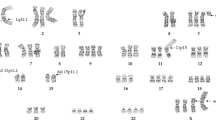Abstract
Murine models of human carcinogenesis are exceedingly valuable tools to understand genetic mechanisms of neoplastic growth. The identification of recurrent chromosomal rearrangements by cytogenetic techniques serves as an initial screening test for tumour specific aberrations. In murine models of human carcinogenesis, however, karyotype analysis is technically demanding because mouse chromosomes are acrocentric and of similar size. Fluorescence in situ hybridization (FISH) with mouse chromosome specific painting probes1 can complement conventional banding analysis. Although sensitive and specific, FISH analyses are restricted to the visualization of only a few mouse chromosomes at a time. Here we apply a novel imaging technique2 that we developed recently for the visualization of human chromosomes3 to the simultaneous discernment of all mouse chromosomes. The approach is based on spectral imaging to measure chromosome-specific spectra after FISH with differentially labelled mouse chromosome painting probes. Utilizing a combination of Fourier spectroscopy, CCD-imaging and conventional optical microscopy, spectral imaging allows simultaneous measurement of the fluorescence emission spectrum at all sample points. A spectrum-based classification algorithm has been adapted to karyotype mouse chromosomes. We have applied spectral karyotyping (SKY) to chemically induced plasmocytomas, mammary gland tumours from transgenic mice overexpressing the c-myc onco-gene and thymomas from mice deficient for the ataxia telangiectasia (Atm) gene. Results from these analyses demonstrate the potential of SKY to identify complex chromosomal aberrations in mouse models of human carcinogenesis.
This is a preview of subscription content, access via your institution
Access options
Subscribe to this journal
Receive 12 print issues and online access
$209.00 per year
only $17.42 per issue
Buy this article
- Purchase on Springer Link
- Instant access to full article PDF
Prices may be subject to local taxes which are calculated during checkout
Similar content being viewed by others
References
Rabbitts, P. et al. Chromosome specific paints from a high resolution flow karyotype of the mouse. Nature Genet. 9, 369–375 (1995).
Malik, Z. et al. Fourier transform muitipixel spectroscopy for quantitative cytology. J. Microscopy 182, 133–140 (1996).
Schröck, E. et al. Multicolor spectral karyotyping of human chromosomes. Science 273, 494–497 (1996).
Speicher, M.R., Ballard, S.G. & Ward, D.C. Karyotyping human chromosome by combinatorial multi-fluor FISH. Nature Genet. 12, 368–375 (1996).
Kastan, M. Experimental models of human carcinogenesis. Nature Genet. 5, 207–208 (1993).
Potter, M. & Wiener, F. Piasmocytomagenesis in mice: model of neoplastic development dependent upon chromosomal translocations. Carcinogenesis 13, 1681–1697 (1992).
Fearon, E.R. & Vogelstein, B. A genetic model for colorectal carcinogenesis. Cell 61, 759–767 (1990).
Bieche, I. & Lidereau, R. Genetic alterations in breast cancer. Genes Chrom. Cancer 4, 227–251 (1995).
Cardiff, R.D. & Muller, W.J. Transgenic models of mammary tumorigenesis. Cancer Surveys 16, 97–113 (1993).
Leder, A., Pattengale, P.K., Kuo, A., Stewart, T. & Leder, P. Consequences of widespread deregulation of the c-myc gene in transgenic mice: multiple neoplasms and normal development. Cell 45, 485–495 (1986).
Amundadottir, L.T. et al. TGFα and c-myc cooperation in mouse mammary tumorigenesis: coordinate stimulation of growth and suppression of apoptosis. Oncogene 13, 757–765 (1996).
Capecchi, M.R. Altering the genome by homologous recombination. Science 244, 1288–1292 (1989).
Barlow, C. et al. Atm-deficient mice:a paradigm of ataxia telangiectasia. Cell 86, 159–171 (1996).
Taylor, A.M., Metcalfe, J.A., Thick, J. & Mak, Y.F. Leukemia and lymphoma in ataxia telangiectasia. Blood 87, 423–438 (1996).
Telenius, H. et al. Cytogenetic analysis by chromosome painting using DOP-PCR amplified flow sorted chromosomes. Genes Chrom. Cancer 4, 267–263 (1992).
Author information
Authors and Affiliations
Corresponding author
Rights and permissions
About this article
Cite this article
Liyanage, M., Coleman, A., Manoir, S. et al. Multicolour spectral karyotyping of mouse chromosomes. Nat Genet 14, 312–315 (1996). https://doi.org/10.1038/ng1196-312
Received:
Accepted:
Issue Date:
DOI: https://doi.org/10.1038/ng1196-312
This article is cited by
-
Multi-target spectrally resolved fluorescence lifetime imaging microscopy
Nature Methods (2016)
-
SubcloneSeeker: a computational framework for reconstructing tumor clone structure for cancer variant interpretation and prioritization
Genome Biology (2014)
-
The onset of p53 loss of heterozygosity is differentially induced in various stem cell types and may involve the loss of either allele
Cell Death & Differentiation (2014)
-
The exon junction complex component Magoh controls brain size by regulating neural stem cell division
Nature Neuroscience (2010)



